#Shopify Like a Pro
Explore tagged Tumblr posts
Text

Beyond Themes: Customizing Shopify Like a Pro
Uncover advanced strategies for personalizing your Shopify store, enhancing user engagement, and driving more conversions with expert advice from a skilled Shopify developer.
0 notes
Text

Advanced Shopify Customization Techniques
Dive into advanced Shopify customization techniques. Enhance your store's functionality and design with expert-level modifications, ensuring a seamless shopping experience for your customers.
#Best Shopify development company#Customizing Shopify#hire Shopify developer#hire Shopify developers#Shopify development company#Shopify development services#Shopify development services in USA#Shopify Like a Pro#Shopify Themes
0 notes
Text
youtube
In this video, I explain the "awaiting recovery" status in Buyist Pro. This status occurs when an order hasn't been successfully sent to fulfillment and requires action to correct the issue. I discuss how this differs from other order statuses and what happens when there's a problem pushing orders to systems like ShipStation or Shopify. Importantly, I clarify that customers aren't notified of these issues - they see the thank you page and receive an order confirmation as normal. However, the order remains stuck in Buyist Pro. I explain that this isn't a reason to reject the order, but instead, you'll receive a critical notification with a direct link to address the problem in the customer screen.
20 notes
·
View notes
Text
Planning to sell physical or digital products online and want to create a website for it in the FASTEST way?
If you're starting your e-commerce journey and feeling overwhelmed by all the platform options—don't worry, you're not alone. Two names dominate the conversation: Shopify and WordPress (with WooCommerce).
But which one is truly better for newbies, beginners, and dropshippers looking to launch fast and sell efficiently?
Let’s break it down and get straight to the point—especially if you're here to build a business, not fiddle with tech headaches.
Shopify: Built for E-Commerce from the Ground Up
Shopify is a dedicated e-commerce platform. That means everything from product setup to payments, themes, and shipping is purpose-built for one thing: selling online.
Why Shopify is Great for Beginners
Zero Coding Required: Just drag, drop, and start selling. Perfect for people who want results, not tutorials.
3-Day Free Trial: You can start today and be up and running in hours.
Sign up for Shopify’s FREE trial with this link -
https://shopify.pxf.io/QjzmOa
Fast Setup: No plugins, no server setup, no manual installation. Just sign up and start building.
Designed for Dropshipping: Integrates easily with apps like DSers, Zendrop, CJdropshipping, and more.
Mobile-Optimized: Your store will look great on any device—without touching a line of code.
24/7 Support: Real-time help from actual people when you get stuck.
Sign up for a Shopify FREE TRIAL Here at https://shopify.pxf.io/QjzmOa
WordPress (WooCommerce): Powerful, But Not Beginner-Friendly
WordPress is an amazing platform... if you're building a blog or you’re already experienced with web development. But for e-commerce newbies, it can feel like you're building a house from scratch.
Why WordPress Might Be a Struggle for Beginners
Complex Setup: You'll need to buy hosting, install WordPress, then install WooCommerce, then configure it all manually.
Plugin Overload: Want a feature? You’ll likely need to install a plugin. And another. And another. Then update them constantly.
Security Risks: If you don’t stay on top of updates and patches, your site could be vulnerable.
Slow Support: There’s no dedicated support team—just forums or your hosting provider.
Not Built for E-commerce First: WordPress is a blogging tool at heart.
WooCommerce makes it work for selling, but it’s not seamless.
So Which One Should You Choose?
If you're:
A beginner with no coding experience,
A dropshipper who wants fast supplier integration,
Or just someone who wants to get your first product online this week, not next month...
Go with Shopify.
It’s clean, easy to use, beginner-friendly, and built to sell. You won’t waste time on tech issues—you’ll spend time building a brand.
Pro Tip: You can start with a 3-day free trial and see how easy it is. No risk, no commitment.
Sign up for a Shopify FREE TRIAL Here - https://shopify.pxf.io/QjzmOa
Manual Setup
Shopify was made for people just like you—dreamers and doers ready to launch something real.
Don’t get stuck in tech setup and plugin chaos.
2 notes
·
View notes
Text
Upselling vs Cross Selling: Which One Drives More Revenue in Shopify?

If you run a Shopify store, you've probably heard about upselling and cross selling as strategies to increase revenue. Both techniques aim to boost the average order value (AOV), but they do so in different ways. While upselling encourages customers to purchase a higher-end version of a product, cross-selling suggests complementary items to enhance their purchase.
But which one is more effective for Shopify merchants?
In this blog, we’ll break down upselling vs cross selling, explore their advantages, and provide actionable tips to implement them effectively.
What is Upselling?
Upselling is a technique that persuades customers to buy a better, upgraded, or premium version of the product they are considering. The main goal of upselling is to maximize the value of a single purchase.
Examples of Upselling:
A customer adds a basic laptop model to their cart, and they are shown a higher-end version with better specs at a discounted rate.
While booking a flight, the airline offers an upgrade to business class for a small extra fee.
A coffee shop suggests getting a large-sized latte instead of a medium one for a slight price difference.
🔹 Why It Works: Customers are already interested in the product, so upgrading for extra features or benefits feels like a natural choice rather than an additional expense.
What is Cross Selling?
Cross-selling involves recommending related or complementary products to the one a customer is purchasing. Instead of upgrading, this technique encourages buyers to add extra items that go well with their current purchase.
Examples of Cross Selling:
A customer buys a mobile phone, and the store suggests adding a phone case and screen protector.
A fashion store recommends a matching belt and shoes when someone buys a suit.
An electronics retailer suggests buying a wireless mouse and keyboard along with a laptop.
🔹 Why It Works: Cross-selling helps customers get a more complete shopping experience by offering items that enhance their primary purchase.
Upselling vs Cross Selling: Which is Better for Shopify?

Both upselling and cross selling help businesses increase revenue, but their effectiveness depends on the type of products you sell and your customer behavior.
1. Customer Buying Intent
Upselling works best when customers are already convinced about buying a product but might consider an upgraded version with more value.
Cross-selling works best when customers are interested in enhancing their shopping experience with complementary products.
2. Impact on Average Order Value (AOV)
Upselling directly increases AOV by replacing a lower-cost product with a higher-priced alternative.
Cross-selling boosts AOV by adding multiple items to the cart, increasing the total spend.
3. Best Use Cases for Shopify Stores
Upselling is ideal for stores selling electronics, software, or high-value products where customers appreciate better specifications.
Cross-selling works well for fashion, beauty, and home decor brands where accessories or add-ons complement the main product.
Pro Tip: The best Shopify stores use both upselling and cross-selling together to maximize their earnings per customer.
How to Implement Upselling and Cross Selling in Your Shopify Store
1. Use a Shopify Cart Upsell App
Manually setting up upsells and cross-sells can be challenging. The easiest way to automate the process is by using a Shopify cart upsell app. These apps allow you to:
✔️ Show upsell offers inside the cart before checkout.
✔️ Display cross-sell recommendations based on customer preferences.
✔️ Provide bundle discounts to encourage higher spending.
✔️ Personalize upsells with AI-driven recommendations.
Checkout this video on how Icart App help you with Implementing Upselling and Cross Selling in your store.
youtube
2. Offer Limited-Time Upsell Deals
Creating urgency can boost upsell conversions. Try offering:
"Upgrade to a Pro Version and Get 10% Off – Offer Ends in 24 Hours!"
"Buy 2 and Get 1 Free – Only Available Today!"
3. Smartly Place Cross-Sell Recommendations
Cross-sell offers work best when they are presented at the right time and place:
Product Pages – Show related products before the customer adds an item to the cart.
Cart Page – Highlight add-ons that enhance the main product.
Checkout Page – Suggest last-minute add-ons before the final purchase.
4. Provide Bundle Discounts
Customers love value-packed deals! Instead of selling items individually, create discounted product bundles, such as:
A "Complete Skincare Kit" (Cleanser + Toner + Moisturizer) at a special price.
A "Gaming Essentials Pack" (Gaming Laptop + Mouse + Headset) with a bundled discount.
Which Strategy Will Make You More Money?

Both upselling and cross selling are effective, but their impact depends on the type of products you sell:
Choose Upselling If:
✔️ Your store sells high-ticket products that have premium upgrades.
✔️ You want to increase profit margins per order.
✔️ Your customers appreciate better versions of what they’re already buying.
Choose Cross Selling If:
✔️ You want to encourage customers to buy related products together.
✔️ Your store focuses on repeat purchases (fashion, accessories, home decor, etc.).
✔️ You want to improve the overall shopping experience by offering complementary products.
The Best Strategy? Use Both! Shopify stores that integrate upsell and cross sell techniques effectively see the highest revenue growth.
Conclusion
Both upselling vs cross selling play an essential role in increasing revenue for Shopify merchants. Upselling focuses on increasing order value by upgrading products, while cross-selling enhances customer satisfaction with related purchases.
To make the most of these strategies, use a Shopify cart upsell app that automates recommendations, displays offers at the right time, and drives higher conversions effortlessly.
Start implementing these sales strategies today and watch your Shopify revenue grow!
2 notes
·
View notes
Text
Maximize Sales with the Iconic - Countdown Section
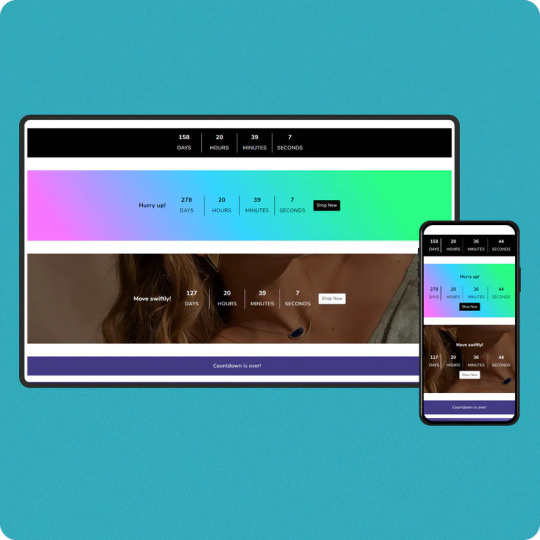
Creating urgency is a proven strategy to drive conversions, and Iconic - Countdown Section is here to help! This Shopify theme section features a countdown timer, designed to grab customer attention and motivate purchases.
If you’re looking to showcase exclusive deals or promotions, this tool is your go-to for boosting sales and customer engagement.
What is the Iconic - Countdown Section?
The Iconic - Countdown Section is a customizable timer that you can embed in your Shopify store. Designed to create a sense of urgency, it encourages shoppers to act quickly, whether it's for limited-time deals, exclusive offers, or upcoming product launches.
This tool isn’t just functional—it’s a proven psychological tactic. Urgency pushes customers to make quicker decisions, reducing cart abandonment and increasing sales.
Benefits of Using the Countdown Section
Boost ConversionsThe ticking clock motivates customers to act fast, creating a fear of missing out (FOMO). Use it for flash sales, seasonal discounts, or countdowns to new arrivals.
Enhance Customer EngagementInteractive elements like countdowns grab attention, making your store more engaging and memorable.
Highlight Special OffersShowcase time-sensitive promotions prominently and encourage bulk purchases during the limited timeframe.
Customizable DesignMatch the countdown's style to your store’s theme. Whether you prefer bold, minimalistic, or colorful designs, Iconic offers flexibility.
Mobile-ResponsiveThe countdown section is optimized for all devices, ensuring your offers look fantastic on both desktop and mobile.
How to Use the Iconic - Countdown Section
Choose Your GoalDecide whether to use the countdown for flash sales, promotional events, or product launches.
Set the TimerCustomize the start and end time for your offer. Adjust fonts, colors, and alignment to suit your store's branding.
Promote StrategicallyPlace the countdown on your homepage, product pages, or cart pages to capture maximum attention.
Monitor PerformanceUse Shopify analytics to track sales spikes and refine your strategy for future campaigns.
Why Choose Iconic for Your Shopify Store?
The Iconic - Countdown Section is more than just a timer; it’s a sales-boosting powerhouse. Backed by an intuitive interface, it integrates seamlessly into any Shopify theme, ensuring smooth operation without compromising on speed or design.
Whether you’re running a small business or managing a high-traffic store, this section fits perfectly into your sales strategy.
Learn More with Our YouTube Video!
Want a step-by-step guide on setting up the Iconic - Countdown Section? Watch our comprehensive YouTube tutorial and become a pro in no time!
youtube
Watch Now
Take Your Store to the Next Level
Create urgency, drive conversions, and maximize sales with the Iconic - Countdown Section. This feature isn’t just a timer—it’s your key to unlocking a new level of customer engagement and revenue.
If you want to download the Shopify app Iconic Sections, click here for more themes like this. Transform your store with expertly designed sections to boost sales and engagement effortlessly!
If you’re looking for expert Shopify development and customization, is here to help. We specialize in creating tailored solutions for Shopify stores, ensuring your success in the competitive e-commerce world.
Get started today and let the countdown begin!
5 notes
·
View notes
Text
youtube
Live Product Quality check करे सीखें Ecommerce Marketing Course Training institute Sanganer #reels https://www.youtube.com/shorts/7N1pQZoYi0g No-1 Ecommerce Marketing Training Institute in Sanganer Jaipur | ……………………………………………………………………………………….. EDM TECH PRO || 📞8306861333 Get Free Demo …………………………………………………………………………………………. Join Best Ecommerce Marketing Training Institute in Sanganer Jaipur🚀 📞8306861333 Get Free Demo Class!👨🏫…!!🚀 Learn:-🎓🎓 …………………………………………………………………………………………………. Advance Ecommerce Marketing By Google Certified Professionals! Like: ✔Amazon,✔ Flipkart, ✔ Meesho, ✔ Etsy, ✔ eBay, ✔ Myntra, ✔ Alibaba ✔ Shopify ✔ Dropshipping ✔ Social Media…!! ………………………………………………………………… Get 100% Job Placement💯 Increase Your Sales, Now! ………………………………………… call📞/WhatsApp:8306861333 Visit: www.edmtechpro.com
EDM #EDMTECHPRO #ecommercemarketingcourse #Onlineproductlistingcourse #onlinesellingtraining
#dmengineersacademy#ecommercemarketingcourse#digitalmarketingcourse#ecommerce#onlinemarketing#digitalmarketing#ecommercecmarketingcourse#ecommercemarketing#jaipur#courses#Youtube
2 notes
·
View notes
Text
👉 Neuro Review ✅ Features, Pricing, Bonuses, Discount and OTOs 🚀

🧠 Overview
Neuro Review is a cutting-edge AI-powered tool designed to simplify content creation, video editing, and marketing efforts by leveraging advanced automation and analytics. Perfect for marketers, content creators, and small business owners. 🚀
👉 Click Here for Get Instant Access Neuro 🖰 >>
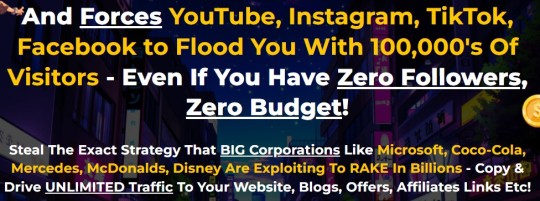

👉 Click Here for Get Instant Access Neuro 🖰 >>
✨ Features of Neuro Review
AI-Powered Content Creation 🖋️ Automatically generates high-quality, SEO-friendly articles, product reviews, and blog posts.
Video Review Editor 🎥 Create and edit product review videos with ease using templates and AI assistance.
Voiceover Generator 🎙️ AI-powered voiceovers in multiple languages and accents.
Analytics Dashboard 📊 Track performance metrics like views, engagement, and conversions.
Integration Capabilities 🔗 Works seamlessly with platforms like WordPress, Shopify, and YouTube.
Multilingual Support 🌍 Expand your reach with content and videos in multiple languages.
User-Friendly Interface 😌 Intuitive and beginner-friendly design to save time and effort.
💲 Pricing
Front-End Plan: Starts at $47 one-time. Includes core features like content creation and video editing.
OTO 1: Pro Version 🚀: Price: $97 one-time Unlock advanced features like unlimited projects, premium templates, and analytics.
OTO 2: Agency License 🏢: Price: $197 one-time Offers agency rights, client management tools, and bulk project handling.
OTO 3: Reseller License 🔁: Price: $297-$497 Allows you to sell the tool and keep 100% of the profits.
👉 Click Here for Get Instant Access Neuro 🖰 >>
🎁 Bonuses
When purchasing Neuro Review through promotional links, you may receive:
Exclusive Training Videos 📚 Master the platform and its features with detailed tutorials.
Content Marketing Toolkit 🛠️ E-books and resources to enhance your marketing strategy.
Custom Templates 🖼️ Unique designs for faster project completion.
Lifetime Updates 🔄 Stay ahead with the latest features at no extra cost.

👉 Click Here for Get Instant Access Neuro 🖰 >>
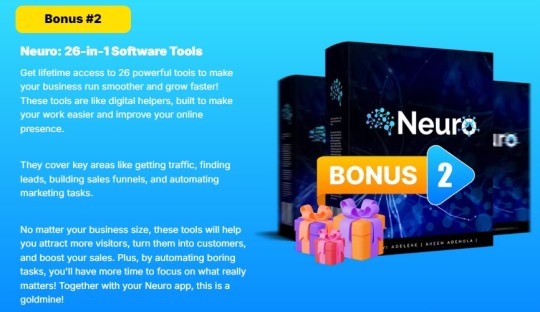
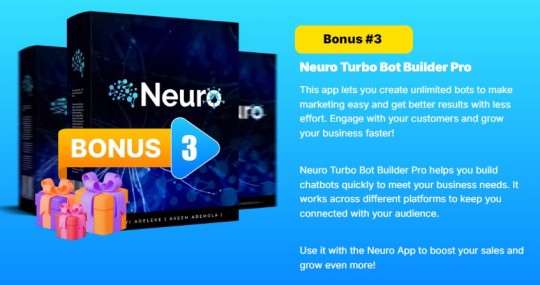
👉 Click Here for Get Instant Access Neuro 🖰 >>
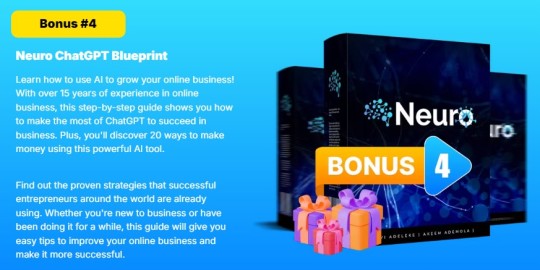

👉 Click Here for Get Instant Access Neuro 🖰 >>
🔥 Discounts and Special Deals
Early Bird Offer: Get 20% off during the launch week.
Bundle Discount: Save up to 30% by purchasing the full OTO package.
Use Coupon Code: 30% Off Cyber Monday Offer For The First 25 People!
🚀 Why Choose Neuro Review?
Saves time with automation.
Boosts productivity and engagement.
Offers versatility with content and video creation tools.
👉 Click Here for Get Instant Access Neuro 🖰 >>
💬 Final Thoughts
Neuro Review is an excellent choice for anyone looking to streamline content and video marketing efforts. With its advanced features and competitive pricing, it's a must-have tool for modern marketers. 🌟

👉 Click Here for Get Instant Access Neuro 🖰 >>
Frequently Asked Questions!
Q. Do I need any experience to get started?
None, all you need is just an internet connection.
And you’re good to go
Q. Do I need to purchase anything else for it to work?
Nop, Neuro is the complete thing.
You get everything you need to make it work. Nothing is left behind.
Q. Is there any monthly cost?
Depends, If you act now, NONE.
But if you wait, you might end up paying $997/mo
It’s up to you.
Q. How long does it take to make money?
Our average member made their first sale the same day they got access to Neuro.
Q. What if I failed?
While that is unlikely, we removed all the risk for you.
If you tried Neuro and failed, we will refund you every cent you paid
Q. How can I get started?
Awesome, I like your excitement, All you have to do is click any of the buy buttons on the page and secure your copy of Neuro at a one-time fee
👉 Click Here for Get Instant Access Neuro 🖰 >>
#apollo neuro review#apollo neuro#neuro review#review#nclex neuro review#apollo neuro reviews#apollo neuro device#neuro#neuro nclex review#brooks neuro review#reviews apollo neuro#reviews#reviews of apollo neuro#apollo neuro review reddit#apollo neuroscience review#nclex review neuro disorders#neuro disorders nclex review#apollo review#neurogum review#apollo neuro review: hrv training with vibration#apollo neuro band#board review#nclex review#marketing#affiliatemarketing#onlinemarketing#software#preview#digitalmarketing
2 notes
·
View notes
Text
Singapore Cheap Shipping Ratings
Going to be starting a series of reviews for merch manufacturing 'n stuff from Singapore. Tag is #merch hell.
As always, I go into detail on my process in my newsletter, which comes with free bird facts, so check it out if you haven't.
Introducing: Singapore Couriers
Shipping is expensive, especially overseas to the other side of the world. If you're in Southeast Asia, trying to get a half decent shipping rate for your international buyers is...painful. So, without further ado, here are my reviews:
Singpost
Go-to government mailing service.
Recommended:
- Local: Yes
- International: No
Pros:
- You can use stamps on these, and if you have a grandparent who left behind their huge collection or some free handouts, you can subsidize shipping to be pretty cheap.
- Post offices are everywhere, so it's usually a 5 minute walk to drop off your stuff.
Cons:
- You still have to drop your parcels off since there's no door to door pick up
- International tracking disappears off the face of the earth the moment it hits the destination country, which is not ideal. I sent two acrylic charms to the US, and one to Canada....
One caused my friend to go through the effort of calling his post office and dealing with a lot of customer service hell. Another one went missing. That is a pretty bad failure rate. This awful tracking is also well-documented.
Conclusion: If you love your customers, please don't use Singpost as a tracked service. Put disclaimers if you really want discounted tracking.
Justship
Newer shipping startup with competitive prices.
Recommended:
Local: Haven't tried, but there are more well known services (like Ninjavan).
International: Yes! Absolutely! But for smaller parcels, only US/UK is supported at the moment.
Pros:
- Really damn good customer service. Quick responses, friendly, and most importantly, *transparent*.
- Lets you set up a spreadsheet for bulk shipping, and provides integrations with storefronts like Shopify (sadly not BigCartel)
- Tracking in the destination country instead of disappearing
- Door to door pickup
- Parcels don't seem to be tampered with much? At least from what I've seen.
Cons:
- At the moment, there is no tracking while the parcels are being delivered to the destination country. So the opposite of Singpost, but still preferable. (However, they have told me they will be looking into it.)
- For smaller parcels like acrylic charms, cheap shipping only works for the US/UK. For everything else, it automatically defaults to the pricing of a higher volumetric weight, which is way more pricey than Qxpress. (Same as previous bullet point, they have told me they will try to support other countries in the future.)
- Door to door pickup is only for 5 or more deliveries. Otherwise, they expect you to drop it off at their warehouse, which for me is pretty far away.
Conclusion: Easily the best service here. Unfortunately they're a bit limited since they're a smaller company, and bulk orders are better, but the consistent quality is good, especially if you want to provide a good service to your customers (who are already paying 11USD minimum).
Qxpress
Cheap mailing service with a lot of existing big boi infrastructure in place.
Recommended:
- Local: There's better, there's worse. Eh.
- International: Yes for smaller batches (<5) or non US/UK countries
Pros:
- Ships damn near everywhere
- Door to door pickup regardless of order size, parcels, etc. They have dropoff stations too.
Cons:
- Tampers with your packages.
Smaller envelopes are safe, but they also paste a shitton of shipping labels over your stuff, some which may have truncated addresses.
Others have reported that they might open and repack larger parcels. Not exactly the best thing for privacy, or stuff in the parcels remaining intact.
- Door to door pickup takes their sweet time. Again, there are also reports of them missing the pickup.
- Doesn't appear to have a convenient option for bulk shipping, but I may not have noticed it?
Conclusion: Comparable prices to the other two, more flexible, but comes with standard shittiness of a large company cutting costs. Only use this for smaller shipments if Justship won't cut it. Your packages won't get lost, but they sure will get fucked with.
Tl;dr Justship is the GOAT.
4 notes
·
View notes
Text
🔥🔥🔥AiDADY Review: Your All-in-One Tool for Digital Success

Comes with powerful features: AI Dady Review
✅ Brand New AI Tech “AIdady” Replaces Dozens Of Expensive OverPriced Recurring Paid Platforms
✅ Say Goodbye to Paying Monthly To ClickFunnels, Convertri, Wix, Shopify, Shutterstock, Canva, Hubspot e.t.c
✅ Built-in Websites & Funnel Builder: Create Unlimited High Converting Funnels For Any Offer & Stunning Websites For Any Niche Using AI In Just Seconds
✅ Built-in Salescopy & Email Copy Writer: Create Unlimited Sales Copies & Email copies At Ease With AI
✅ Built-in Store Builder: Create Unlimited AI Optimized Affiliate Stores With Winning Products At Lightning Fast Speed
✅ Built-in Blog Builder: Create Unlimited Stunning SEO Optimized Blogs with ease
✅ Built-in AI Content Creator: Create SEO Optimized, Plagiarism-free Contents for any niche using AI
✅ Built-in Stock Platform: Millions of Stock Images, Graphics, Animations, Videos, Vectors, GIFS, and Audios
✅ Built-in Travel Affiliate Sites Creator: Create Unlimited AI driven travel affiliate sites in seconds to grab more attention, traffic & sales
✅ All the AI Apps you’ll ever need for online AI business & digital marketing under one single dashboard
✅ Built-in Ebook & Course Affiliate Sites Creator: Create ebook or course affiliate sites with AI in seconds
✅ 250+ Webtool Website Creator Included
✅ Unlimited Ai Chatbots, Database, AI Code, IOS & Android App Code Creator Included
✅ Built-in Unlimited Internet Data Scraper in any niche, Background Removal & App Monetization
✅ Get 100% Free hosting, No Domain Or Hosting Required
✅ Unlimited Funnels, Unlimited Websites, Unlimited Blogs, Unlimited Stores, Unlimited Affiliate sites & Unlimited Youtube-Like Video Websites
✅ Replace Expensive Monthly OverPriced Platforms With One-Time Payment & Save $27,497.41 Each Year
✅ Start Your Own Digital Marketing Agency & AI Business Without Any Tech Skills or Experience
✅ 100% Cloud Based. Nothing To Download Or Install
✅ Lifetime Access With No Recurring Monthly Payments...
✅ Commercial licence included: create & sell as many funnels, websites, blogs, stores, affiliate sites etc as you want.
✅ Newbie Friendly, Easy-To-Use Dashboard
AI Dady Review: Funnels
FE - ($17)
OTO1: Pro Version ($47)
OTO2 - Unlimited Access ($37)
OTO3: DFY Version ($147)
OTO4: Agency Edition ($147)
OTO5: Automation ($37)
OTO6: Reseller ($67)
>>>>Get Instant Access Now
2 notes
·
View notes
Text
I'm trying to find out if there is a better option for my online shop but man I'm not having much luck.
Etsy is just scummy and sucks. Plus the fees are way higher than I would like. The pros is that they have the search feature. They also don't have a built in way to do commissions.
Shopify is fucking expensive. 30 dollars a month if you pay for a full year at once, a 2.9% credit card processing fee, and you have to buy shipping labels through them. Also no way to do commissions. They do have SEO stuff. I would also be able to use their point of sale system for in person shows and streamline my inventory process.
Ko-fi has the option to pay $5 a month to get rid of fees, I can list free stuff, give people the option to tip on a purchase, and set up commissions through it. The downsides are that I have to market myself (bad at that) and use a clunky system for tracking inventory between online sales and in person sales.
I think I'm just going to stick with ko-fi because it seems like the best solution, even if it's a bit clunky for me to track sales between craft shows and online.
My ideal situation would be Zettle allowing me to open an online shop. It would be less work and the credit card processing fees are cheaper.
I hate running a business.
#chatty cassie#like the point of sale system being streamlined would be nice#but not necessary#i can just do what I have been doing#i just sit down and go through every sale and cross reference with ko-fi#it takes like an hour#but saves me 25 dollars a month lmao
1 note
·
View note
Text
Master Multichannel eCommerce with CedCommerce’s Amazon Channel App
Selling across multiple platforms can be a challenge, but it doesn't have to be! Enter the CedCommerce Amazon Channel app, your ultimate ally in multichannel eCommerce product management.
Why CedCommerce?
Simplified Product Data Optimization: With CedCommerce, you can manage all your sales channels, including Amazon Marketplace, from a single dashboard, making multichannel eCommerce product management a breeze.
Product Feed Optimization is Key
Boosting Sales Potential: Product Feed Optimization is crucial for online businesses. Optimized product feeds can increase sales potential by up to 69% on Amazon alone, according to Forrester Research.
Amazon Product Listing Optimization
Stand Out on Amazon: Learn how to optimize your Amazon product listings for maximum visibility and sales. Follow Amazon's guidelines to improve your products' visibility and ranking in search results.
Understanding Amazon's Algorithm
Cracking the Code: Dive into how Amazon's algorithm ranks products. Discover the factors that affect your product's placement in search results and learn to use them to your advantage.
Amazon Listing Optimization
The Path to Success: Explore the steps involved in optimizing your Amazon listings, from keyword research to product images and backend keywords.
Effortless Multichannel Sales with CedCommerce
Seamless Management: Discover how CedCommerce's Amazon Channel app allows you to connect multiple Amazon accounts with a single Shopify shop, making multichannel sales management a breeze.
Don't let multichannel eCommerce overwhelm you. Streamline your product feed and listings on Amazon with CedCommerce's Amazon Channel app. Elevate your business and handle Amazon Shopify Product feed management like a pro!
Ready to conquer the world of multichannel sales? Learn more by reading the full blog https://bit.ly/3ZC1fsC
#CedCommerce #AmazonChannelApp #MultichannelSelling #ProductFeedOptimization
#cedcommerce#ecommerce#ecommercebusiness#ecommercestore#shopify#shopifyseller#amazon#amazon marketplace
2 notes
·
View notes
Text
QuickBooks vs Sage: A Comprehensive Comparison for Small Businesses
Introduction
As a small business owner, choosing the right accounting software can be a daunting task. With so many options out there, it's hard to know which one is the best fit for your needs. Two of the most popular options on the market are QuickBooks and Sage. But how do they compare?
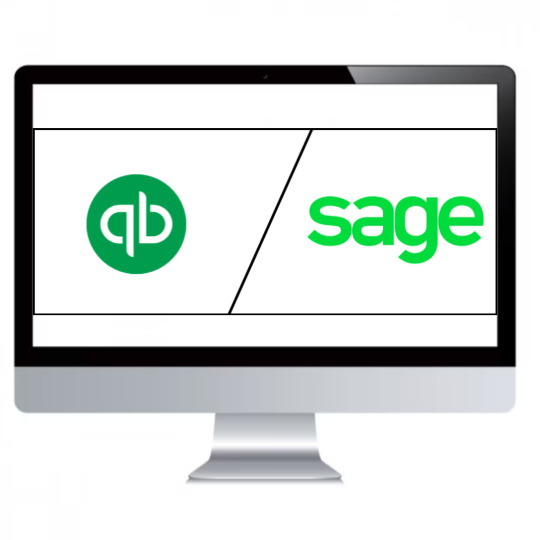
In this QuickBooks vs Sage comprehensive comparison, we'll take a look at both QuickBooks and Sage's features, pricing, pros and cons to help you make an informed decision about which software is right for your small business. So let's dive in!
QuickBooks Overview
QuickBooks is one of the most popular accounting software solutions for small businesses. It was developed and marketed by Intuit, a company that specializes in financial and tax preparation software. QuickBooks is known for its user-friendly interface and extensive features that cater to various business needs.
One of the key benefits of using QuickBooks is its ease of use. The software can be easily installed on your computer or accessed through the cloud-based version, making it accessible anytime, anywhere. Additionally, QuickBooks has a simple dashboard that allows users to track their expenses, income, and profits with just a few clicks.
Another great feature of QuickBooks is its ability to integrate with other applications such as PayPal and Square. This integration makes it easier for businesses to manage their finances without having to switch between multiple platforms.
Moreover, QuickBooks offers several versions tailored to suit different types of businesses including self-employed individuals, small business owners and accountants who work with multiple clients at once. These versions come with varying features such as invoicing capabilities, inventory management tools among others.
If you are looking for an accounting solution that offers easy accessibility combined with extensive functionality then QuickBooks could be the perfect fit for you.
Sage Overview
Sage is another popular accounting software that caters to small and medium-sized businesses. It offers a variety of features that help in managing finances, invoicing customers, and tracking expenses.
One of the key advantages of Sage is its flexibility. It provides users with various customization options to tailor the software's interface according to their needs and preferences. Additionally, it has an intuitive dashboard that displays all important financial information at a glance.
Apart from standard accounting functionalities like bookkeeping and bank reconciliation, Sage also offers advanced inventory management features such as order fulfillment tracking and automated reordering.
Another notable aspect of Sage is its integration capability with other business tools like Microsoft Office 365, Salesforce CRM, and Shopify eCommerce platform. This allows for seamless data exchange between different software applications used by businesses.
Sage is a robust accounting solution suitable for businesses looking for advanced features beyond basic bookkeeping. Its customizable interface and integration capabilities make it stand out among competitors in the market.
QuickBooks vs Sage Feature Comparison
When it comes to comparing QuickBooks vs Sage, one of the most important things to look at is their features. Both software solutions offer a range of tools and functions that can help small businesses manage their finances effectively.
QuickBooks has always been known for its strong focus on accounting features. It offers a comprehensive suite of tools designed to handle everything from invoicing and billing to expense tracking and payroll management. In addition, QuickBooks also provides robust reporting capabilities that enable business owners to get insight into the financial health of their company in real-time.
On the other hand, Sage boasts an impressive array of specialized features that cater specifically to certain industries such as construction, manufacturing, or distribution. These industry-specific functionalities allow businesses operating in these sectors to streamline operations by automating tasks like inventory tracking or job costing.
While both platforms have plenty of useful features for small businesses, it's important to consider which ones are more relevant based on your specific needs. Take some time to evaluate your business requirements before making a decision between QuickBooks vs Sage.
QuickBooks vs Sage Pricing Comparison
When it comes to pricing, both QuickBooks and Sage offer a range of plans that cater to different business needs and budgets. However, there are some notable differences between the two.
QuickBooks offers four main pricing plans: Simple Start, Essentials, Plus, and Advanced. Prices start at $25 per month for Simple Start and go up to $180 per month for Advanced. Each plan includes features like invoicing, expense tracking, and basic reporting tools.
On the other hand, Sage has three main pricing tiers: Accounting Start ($10/month), Accounting ($25/month), and Accounting Premium ($71.67/month). While these prices may seem lower than QuickBooks' offerings on the surface level, it's important to note that each tier is limited in terms of features compared to what QuickBooks offers.
Additionally, both QuickBooks and Sage offer add-ons such as payroll processing or inventory management for an additional cost. It's important for businesses to carefully consider their needs when deciding which plan is right for them.
Ultimately, while there are differences in price between the two platforms depending on your business size and needs; finding out which one works best will depend entirely upon your specific budgeting goals as well as overall objectives
Pros and Cons
When comparing QuickBooks and Sage, it's important to consider the pros and cons of each software. First, let's take a look at some of the advantages of using QuickBooks.
One of the major benefits of QuickBooks is its user-friendly interface. Even if you are not an accounting expert, you can easily navigate through this software. It has a simple dashboard that provides a clear overview of your financial records. Also, it offers robust features such as invoicing, expense tracking and payroll management.
On the other hand, Sage also has its own set of pros. One advantage is its customization capability which allows users to tailor-fit their accounting processes based on their business needs. Additionally, Sage enables multi-user access which supports collaboration among team members in real-time.
However, there are also some cons to consider for both software options. For example, QuickBooks may be too basic for larger businesses with more complex accounting requirements while Sage may have a steeper learning curve compared to other accounting platforms.
Ultimately, deciding between QuickBooks or Sage will depend on your business size and specific needs when it comes to bookkeeping and accounting processes.
Conclusion
After weighing the advantages and disadvantages of QuickBooks vs Sage, it is evident that both software programs have their unique features and benefits. Ultimately, the choice between them depends on a business's specific needs.
QuickBooks is an excellent choice for small businesses looking for easy-to-use bookkeeping software with robust accounting features, mobile accessibility, and affordable pricing options. On the other hand, Sage offers more extensive customization options and advanced reporting capabilities.
Before making any decision about which bookkeeping software to use in your business, you should conduct thorough research into each program's features. However, regardless of which option you choose; investing in either QuickBooks or Sage will give your small business a competitive edge when it comes to managing finances effectively.
3 notes
·
View notes
Text
Dropshipping: Start an E-commerce Business Without Inventory in 2025
Meta Description:
Learn how to start an online store using the dropshipping business model. Discover how to sell products without inventory and build a profitable e-commerce business in 2025.

Introduction: Why Dropshipping Is Still a Top Business Model in 2025
In today’s digital economy, more people are looking for ways to start a business with low risk, low overhead, and high scalability. That’s where dropshipping comes in. With the dropshipping business model, you can start an online store and sell products without inventory, making it one of the most accessible and profitable e-commerce opportunities in 2025.
Whether you’re a beginner or a seasoned entrepreneur, dropshipping allows you to build a brand and generate income online—without ever having to handle physical products.
What Is the Dropshipping Business Model?
Dropshipping is an order fulfillment method where a store doesn’t keep the products it sells in stock. Instead, when a customer places an order, the seller purchases the item from a third-party supplier—usually a wholesaler or manufacturer—who ships it directly to the customer.
As a result, you never need to hold inventory or deal with shipping logistics.
Key Benefits:
Low start-up costs
No inventory management
Wide product selection
Work from anywhere
Scalable and automated processes
How to Start an Online Store Using Dropshipping
Step 1: Choose a Niche
Select a niche you’re interested in with high demand and manageable competition. Popular niches in 2025 include:
Home fitness equipment
Eco-friendly products
Pet accessories
Personal development tools
Tech gadgets
Skincare and beauty
Step 2: Find a Dropshipping Supplier
Use platforms like:
AliExpress
DSers
Spocket
Printful (for print-on-demand products)
Zendrop
Choose suppliers with fast shipping times, reliable customer service, and quality products.
Step 3: Build Your Online Store
Create a website using platforms like:
Shopify (most popular for dropshipping)
WooCommerce (WordPress plugin)
BigCommerce
Design a clean, user-friendly store with optimized product pages, trust signals, and secure checkout.
Step 4: Import Products and Set Pricing
Use apps like DSers or Oberlo (for Shopify) to easily import products from suppliers into your store. Set prices with profit margins in mind, and don’t forget to factor in shipping and transaction fees.
Step 5: Launch and Market Your Store
Use digital marketing strategies to attract customers:
Facebook and Instagram ads
TikTok organic or paid content
Google Shopping ads
SEO for product descriptions and blogs
Influencer marketing partnerships
How to Sell Products Without Inventory Successfully
The key to success in dropshipping lies in the customer experience. Since you don’t control fulfillment, you must:
Choose reliable suppliers
Provide accurate shipping timelines
Offer excellent customer service
Use automated tools to track orders and follow up with customers
Also, focus on building a brand—not just a store. Use unique product descriptions, custom packaging (if possible), and high-quality imagery to create a trustworthy online presence.
Pros and Cons of the Dropshipping Business Model
Pros:
Easy to launch and manage
No need for warehousing or upfront bulk purchases
Test multiple products with little risk
Can be operated from anywhere
Cons:
Lower profit margins than traditional e-commerce
Less control over shipping times and inventory
Higher competition in some niches
Customer service responsibility still falls on you
Final Thoughts: Is Dropshipping Worth It in 2025?
Absolutely. If you want to start an online store without the risk and hassle of managing inventory, dropshipping is still one of the most effective business models available. With the right tools, suppliers, and marketing strategy, you can build a successful e-commerce business that earns income around the clock.
The sooner you start, the faster you can test ideas, learn the ropes, and scale a business that works for you.
Need Personal Or Business Funding? Prestige Business Financial Services LLC offer over 30 Personal and Business Funding options to include good and bad credit options. Get Personal Loans up to $100K or 0% Business Lines of Credit Up To $250K. Also Enhanced Credit Repair ($249 Per Month) and Passive income programs (Can Make 5-10% Per Month; Trade $100K of Someone Esles Money).
Book A Free Consult And We Can Help - https://prestigebusinessfinancialservices.com
Email - [email protected]
Keywords Used: dropshipping business model, start online store, sell products without inventory
Learn More:
Prestige Business Financial Services LLC
"Your One Stop Shop To All Your Personal And Business Funding Needs"
Website- https://prestigebusinessfinancialservices.com
Email - [email protected]
Phone- 1-800-622-0453
1 note
·
View note
Text
Shopify Store Owners, Hiring Just Got Smarter 🧠💻
Looking to launch or scale your Shopify store but stuck finding the right dev? You're not alone. Hiring Shopify developers can feel like throwing darts in the dark 🎯 That’s why we broke down the best platforms to find top Shopify talent in 2025—whether you're after affordable freelancers, elite experts, or vetted pros straight from the Shopify Marketplace. You’ll learn where to hire ,Upwork, Toptal, and more,, what skills to look for ,code, comms, and customization 🔧,, how much to pay 💸, and what red flags to avoid 🚩 If you're serious about building a high-converting store that doesn’t break ,or break the bank,, this guide is your new best friend. Check out the full breakdown here
#shopify#ecommerce#freelancing#developerhiring#smallbusiness#scaleyourstore#outsourcing#remotework#digitalbusiness#shopifystore
0 notes
Text
Simplify and Customize Your Checkout With Checkout Extensions Pro

The checkout experience can make or break a sale. If customers face friction or lack of flexibility during the final step of their shopping journey, they’re more likely to abandon their carts. That’s where Checkout Extensions Pro comes in—a powerful tool designed to help Shopify merchants fully customize, optimize, and simplify their checkout process without compromising on performance or compliance.
What Is Checkout Extensions Pro?
Checkout Extensions Pro is a versatile app tailored for Shopify merchants looking to take full control over their checkout page. It enables store owners to enhance the default Shopify checkout experience by adding features, custom fields, and behavior rules—without writing complex code or needing advanced technical skills.
This solution is especially valuable for growing eCommerce stores that want to collect more information from customers, create conditional workflows, and align the checkout process with their unique business needs.
Why Customization Matters at Checkout
The standard Shopify checkout page is functional, but it doesn’t always suit every brand’s specific needs. Businesses in industries like fashion, food, or personalized products often require additional fields or logic. For example:
Asking customers for delivery instructions
Displaying upsell options based on cart contents
Hiding certain shipping methods under specific conditions
Requesting additional data like tax IDs or custom messages
Checkout Extensions Pro makes these customizations possible, which in turn improves the customer experience, reduces cart abandonment, and increases conversion rates.
Key Features of Checkout Extensions Pro
Here’s what sets Checkout Extensions Pro apart from other Shopify apps:
1. Easy Interface for Checkout Customization
With Checkout Extensions Pro, you don’t need to rely on a developer or dig into Liquid code. The app comes with a drag-and-drop builder that integrates directly with your Shopify admin. This user-friendly interface makes it easy to add, edit, or remove elements on the checkout page without affecting your store's core functionality.
2. Add Custom Fields to Checkout
Need to collect extra information from customers during checkout? The app allows merchants to add Shopify checkout custom fields like text boxes, checkboxes, dropdowns, and more. You can label each field, make them required or optional, and even decide when and to whom they appear.
This feature is ideal for stores that offer personalized products, require specific delivery instructions, or need to gather regulatory data from customers.
3. Set Dynamic Checkout Rules
Business logic at checkout can significantly impact fulfillment and operations. With Checkout Extensions Pro, merchants can implement Shopify checkout rules based on real-time data. For example, you can:
Show or hide shipping options based on location
Display payment methods depending on cart value
Apply discounts when certain items are in the cart
Control access to the checkout page based on customer tags
These rules are set through an intuitive conditions builder, giving you complete control without adding complexity.
4. Mobile and Theme Compatibility
Checkout Extensions Pro is fully responsive and works seamlessly across all modern devices. Whether your customers shop on desktop, tablet, or mobile, the extensions will display properly without interfering with your Shopify theme or checkout flow.
This ensures that the enhanced checkout experience remains consistent and accessible for every user.
5. Compliance-Friendly and Performance Optimized
Unlike custom code solutions, Checkout Extensions Pro maintains full compatibility with Shopify’s latest updates and performance standards. It won’t slow down your checkout or interfere with third-party apps. Plus, it’s built to comply with privacy laws and accessibility guidelines—so your business stays safe and professional.
Use Case Examples
Let’s look at a few ways real stores can use Checkout Extensions Pro to boost revenue and efficiency:
A bakery can ask customers for pickup dates and cake messages.
A clothing brand can offer gift wrapping options as a checkbox.
A B2B supplier can add a field for VAT numbers on business purchases.
A subscription box can hide next-day shipping for recurring orders.
A multilingual store can create checkout flows based on customer language.
Each of these examples demonstrates how a customized checkout experience leads to better customer satisfaction and smoother order processing.
How It Enhances the Shopify Checkout Extension Framework
Shopify recently opened up the ability for developers to create Shopify checkout extension apps that integrate directly into the checkout flow. Checkout Extensions Pro leverages this framework to offer even more powerful enhancements—secure, fast, and seamlessly built into Shopify’s infrastructure.
That means merchants get the flexibility they need without risking stability or compatibility with future platform updates.
Final Thoughts
Checkout Extensions Pro is the go-to app for Shopify merchants who want to personalize the final step of the buyer journey. Whether you need to add a single custom field or redesign the logic of your entire checkout process, this tool provides a flexible, intuitive way to get the job done.
It’s time to move beyond the default Shopify checkout. With Checkout Extensions Pro, you can deliver a smoother, smarter, and more satisfying experience for every customer—while saving time and boosting your bottom line.
Ready to upgrade your checkout? Try Checkout Extensions Pro today and start building a checkout experience that works for your business.
0 notes